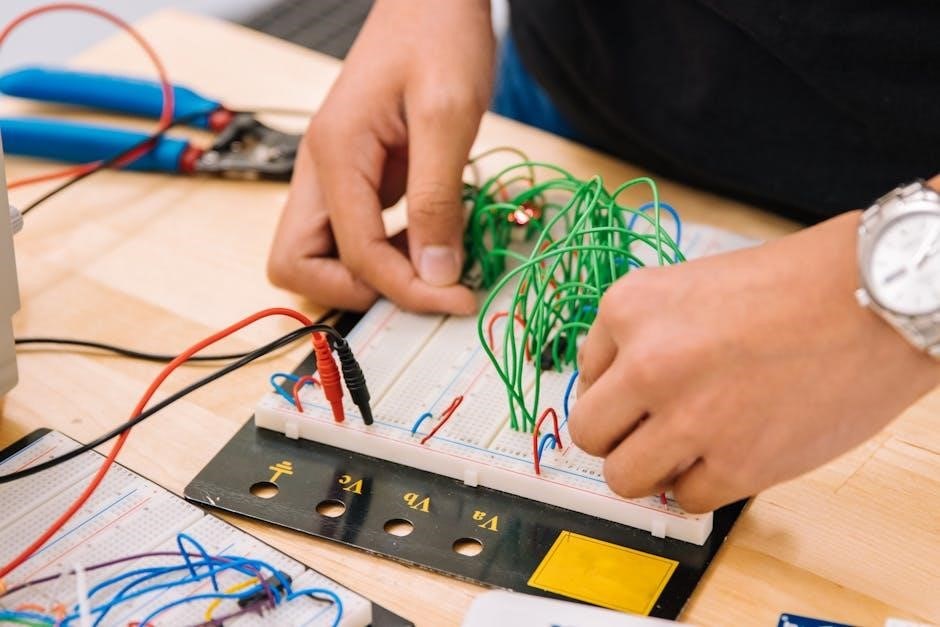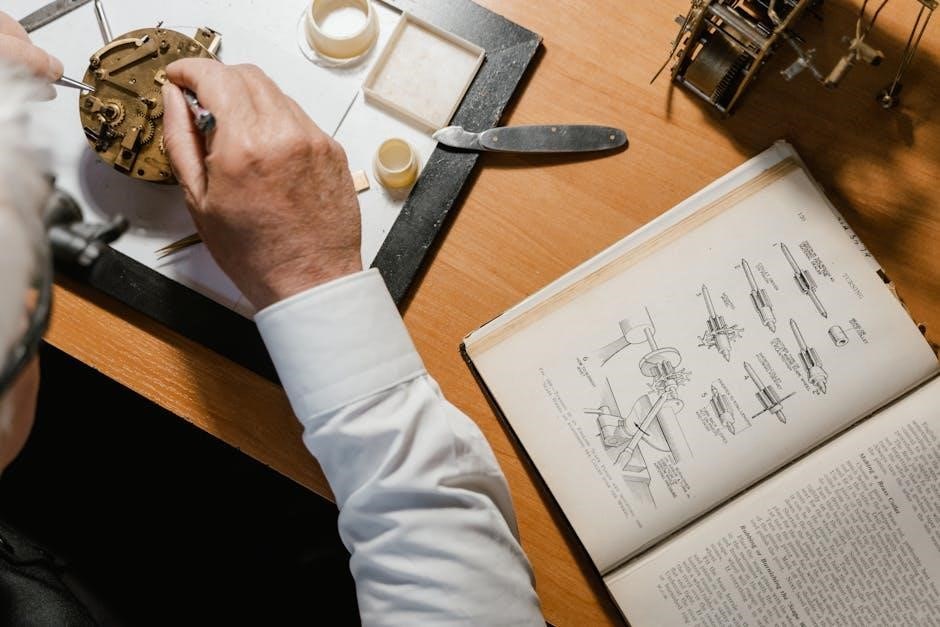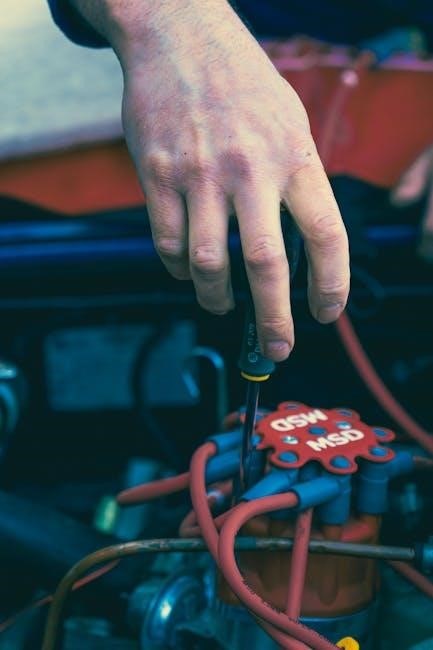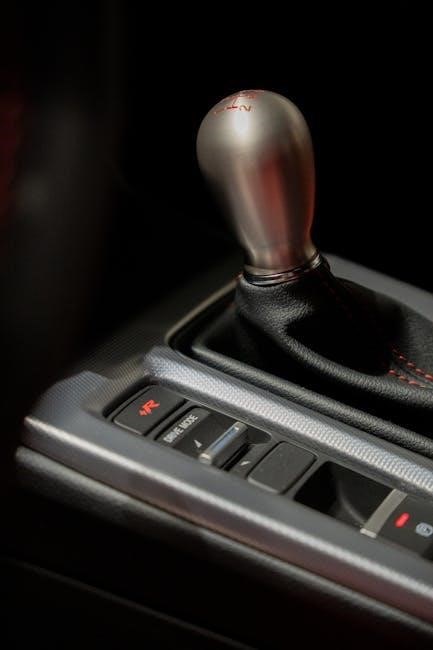The Power Probe 3 is a revolutionary circuit tester designed for diagnosing 12 to 24-volt automotive electrical systems. It combines advanced features like a digital voltmeter‚ power and ground application‚ and an auxiliary ground cable for efficient testing. With its auto power turn-off function‚ the PP3 streamlines troubleshooting‚ making it an essential tool for technicians.
1.1 Overview of the Power Probe 3
The Power Probe 3 (PP3) is a cutting-edge circuit tester designed for diagnosing 12 to 24-volt automotive electrical systems. It functions as a digital voltmeter‚ enabling precise voltage measurements. The device can apply power and ground directly‚ simplifying component testing. An auxiliary ground cable allows users to supply battery voltage and ground simultaneously‚ facilitating continuity and component activation tests. The PP3 operates in multiple modes‚ including Power Probe Mode‚ Hook Mode‚ and Voltage Mode‚ offering versatility for various diagnostic tasks. Its advanced features‚ such as auto power turn-off and LED indicators‚ enhance efficiency and safety. The PP3 is a versatile tool for technicians‚ combining power‚ precision‚ and ease of use to streamline troubleshooting.
1.2 Importance of Reading the Instruction Manual
Reading the Power Probe 3 instruction manual is essential to ensure safe and effective use of the device. The manual provides detailed information about the tool’s features‚ operating modes‚ and safety guidelines. It helps users understand proper techniques for diagnosing electrical systems‚ preventing damage to the tool or the vehicle. By following the manual‚ users can avoid common mistakes‚ such as incorrect connections or misinterpretation of readings. The manual also outlines troubleshooting steps for resolving issues and maximizing the tool’s performance. Familiarizing yourself with the manual ensures compliance with safety standards and enables you to leverage the full potential of the Power Probe 3 for accurate and efficient diagnostics. Proper usage begins with a thorough understanding of the guide.
1.3 Safety Precautions
When working with the Power Probe 3‚ adhering to safety precautions is crucial to avoid accidents or damage. Always ensure the probe is turned off before connecting it to a battery or electrical system. Wear protective gear‚ such as gloves and safety glasses‚ to prevent injury from sparks or electrical discharges. Avoid touching metal parts of the probe while it is in use‚ as this can cause electrical shock. Keep the device away from water and flammable materials. Never use damaged cables or accessories‚ as they may lead to malfunction. Ensure proper ventilation and avoid overheating the tool. Follow the recommended voltage and current limits to prevent damage. Always disconnect the probe correctly to avoid short circuits. Regularly inspect the tool for wear and tear. By following these precautions‚ you can ensure safe and reliable operation of the Power Probe 3.

Key Features of the Power Probe 3
The Power Probe 3 offers advanced diagnostic capabilities‚ including a digital voltmeter‚ power and ground testing‚ auxiliary ground cable functionality‚ and an auto power turn-off feature.
2.1 Digital Voltmeter Functionality
The Power Probe 3 features an integrated digital voltmeter‚ enabling precise voltage measurements in automotive electrical systems. With a range of 0 to 60V DC‚ it provides accurate readings for diagnosing voltage drops‚ open circuits‚ and faulty components. The digital display ensures clarity‚ even in low-light conditions‚ making it easier to identify issues quickly. This functionality is essential for troubleshooting battery‚ alternator‚ and wiring systems. Users can rely on its precision to verify the integrity of power and ground connections‚ ensuring efficient and accurate diagnostics. The voltmeter’s user-friendly interface simplifies the process of identifying electrical system malfunctions‚ making it a vital tool for professionals and enthusiasts alike.
2.2 Power and Ground Application
The Power Probe 3 is designed to simplify the process of applying power and ground in automotive electrical systems. By connecting the probe to the vehicle’s battery‚ users can directly power circuits or components for testing purposes. The ground application ensures a safe and stable connection‚ preventing damage to the tool or the vehicle’s electrical system. This feature is particularly useful for activating components like fuel pumps‚ fans‚ and relays to test their functionality. The probe’s ability to apply power and ground simultaneously allows for quick and accurate diagnoses of electrical issues. It eliminates the need for additional wiring or splicing‚ making it a convenient and efficient tool for technicians and DIY enthusiasts.
2.3 Auxiliary Ground Cable Usage
The auxiliary ground cable is a crucial component of the Power Probe 3‚ designed to provide a safe and reliable ground connection during testing. This cable should be connected to a clean‚ bare metal surface on the vehicle’s chassis or frame to ensure proper grounding. Proper use of the auxiliary ground cable minimizes electrical interference and prevents damage to the tool or the vehicle’s electrical system. It is essential for maintaining accurate voltage readings and ensuring safe operation. Regularly inspect the cable for damage or corrosion to guarantee optimal performance; Always follow the manufacturer’s guidelines for connecting the auxiliary ground cable to avoid any potential risks or inaccuracies during testing. This feature enhances the overall functionality and reliability of the Power Probe 3.
2.4 Auto Power Turn-Off Function
The Power Probe 3 features an Auto Power Turn-Off function‚ designed to conserve battery life and enhance operational efficiency. This feature automatically shuts off the device after a predetermined period of inactivity‚ typically 10 minutes‚ to prevent unnecessary battery drain. The auto power turn-off function is particularly useful during extended diagnostic sessions or when the tool is left unattended. However‚ it does not activate during continuous voltage monitoring to ensure uninterrupted testing. This energy-saving capability prolongs the lifespan of the battery and reduces the need for frequent recharging. The Auto Power Turn-Off function is a convenient and practical addition to the Power Probe 3‚ making it more user-friendly and efficient for professionals and enthusiasts alike.

Operating Modes of the Power Probe 3
The Power Probe 3 offers three primary operating modes: Power Probe Mode‚ Hook Mode‚ and Voltage Mode. Each mode serves distinct functions‚ ensuring versatile diagnostic capabilities for users.
3.1 Power Probe Mode
The Power Probe Mode is the primary operational setting of the Power Probe 3‚ enabling users to apply power and ground directly to components for testing. This mode simplifies troubleshooting by allowing users to activate components such as lights‚ motors‚ and relays without the need for additional wiring. By connecting the probe to a battery and using the ground clip‚ users can instantly test the functionality of circuits and components. This mode is particularly useful for diagnosing electrical issues in vehicles‚ as it provides a straightforward way to isolate and test individual components. Always ensure the device is set to the correct voltage (12V or 24V) to avoid damage to the circuit or the probe itself.
3.2 Hook Mode
Hook Mode on the Power Probe 3 allows users to measure voltage in a circuit without applying external power. This mode is ideal for diagnosing electrical systems by monitoring live circuits. To use Hook Mode‚ connect the probe tip to the circuit under test and ensure the ground clip is securely attached to a good ground point. The device will display the voltage reading on its digital voltmeter‚ providing accurate measurements. Hook Mode is particularly useful for identifying voltage drops or verifying the presence of power in a circuit. Always ensure the probe is set to the correct voltage range (12V or 24V) to avoid incorrect readings. This mode is essential for troubleshooting electrical systems efficiently and safely;
3.3 Voltage Mode
Voltage Mode on the Power Probe 3 enables precise measurement of voltage between two points in a circuit. This mode functions similarly to a standard digital voltmeter‚ providing accurate voltage readings. To use Voltage Mode‚ connect the probe tip to the positive terminal of the circuit and the ground clip to the negative terminal or a suitable ground point. The device will display the voltage with high resolution (0.1V increments). Always ensure the probe is set to the correct voltage range (12V or 24V) for accurate measurements. Voltage Mode is ideal for diagnosing low voltage conditions‚ verifying battery voltage‚ or checking alternator output. Avoid reversing the polarity to prevent damage to the probe or the circuit under test. This mode is essential for precise voltage monitoring and troubleshooting electrical systems.

Hooking Up and Testing with the Power Probe 3
This section guides you through connecting the Power Probe 3 to a battery‚ using the auxiliary ground clip‚ and performing basic tests safely and accurately.
Follow these steps to ensure proper setup and reliable results.
4.1 Connecting the Power Probe 3 to a Battery
To connect the Power Probe 3 to a battery‚ ensure the device is set to the correct mode and the battery is turned off. Attach the green clip to the positive terminal and the black clip to the negative terminal. Always verify polarity to avoid damage. Use the auxiliary ground cable for additional stability if needed. For vehicles with sensitive electronics‚ connect the Power Probe 3 through the cigarette lighter adapter to prevent power surges; Ensure all safety precautions are followed to avoid electrical shock or damage to the device. Proper connection is essential for accurate readings and safe operation. Always refer to the manual for specific guidelines tailored to your vehicle’s electrical system.
4.2 Using the Auxiliary Ground Clip
The auxiliary ground clip on the Power Probe 3 provides an additional grounding point for stable measurements. To use it effectively‚ attach the clip to a clean‚ bare metal surface on the vehicle’s chassis or frame. Avoid painted or corroded surfaces‚ as this may compromise conductivity. Ensure the clip is securely fastened to prevent loose connections. The auxiliary ground clip is especially useful in environments with electrical noise or interference‚ as it helps maintain accurate readings. Never use the auxiliary ground clip on live circuits or components‚ as this could cause damage or safety risks. Regularly inspect the clip for wear or corrosion to ensure optimal performance. Proper use enhances the reliability of your measurements during troubleshooting and testing.
4.3 Testing for Voltage
To test for voltage using the Power Probe 3‚ ensure the device is in Voltage Mode. Select the appropriate voltage range (DC or AC) based on the circuit being tested. Touch the probe tip to the circuit point while maintaining a secure connection with the auxiliary ground clip. The digital voltmeter will display the voltage reading. Always verify that the circuit is de-energized or safely powered down before testing. Avoid touching live circuits with your hands to prevent electrical shock. Use the auxiliary ground clip for stable readings‚ especially in noisy environments. If the reading fluctuates‚ check for loose connections or interference. The Power Probe 3’s auto shut-off feature will conserve battery life during extended use. Always refer to the vehicle’s wiring diagram for accurate voltage testing.

Testing Procedures with the Power Probe 3
This section explains how to perform continuity‚ polarity‚ and voltage tests‚ as well as how to activate components for accurate diagnosis of electrical systems.
5.1 Continuity Testing
Continuity testing with the Power Probe 3 helps identify if there is an uninterrupted path in a circuit or wire. Set the device to Continuity Mode‚ then touch the probes to the circuit’s start and end points. The probe will emit a beep and illuminate an LED if continuity is present. This feature is essential for diagnosing open circuits or faulty connections. Always ensure the circuit is de-enerized before testing to prevent damage or injury. Use the auxiliary ground clip for stable readings. If no continuity is detected‚ inspect the circuit for breaks or corrosion; This test is a quick and reliable way to pinpoint issues in electrical systems. Proper technique ensures accurate results and safe operation.
5.2 Polarity Testing
Polarity testing with the Power Probe 3 allows users to verify the correct voltage direction in a circuit. This is crucial for ensuring components function properly and preventing damage. To test polarity‚ set the probe to Voltage Mode and connect the positive and negative leads to the circuit points. The probe will display the voltage reading‚ and the LED will glow blue for positive polarity or red for negative. If the polarity is reversed‚ the LED will flash red. Always ensure the circuit is de-energized before testing to avoid electrical hazards. Polarity testing is especially useful for diagnosing issues in diodes‚ fuses‚ or rectifiers. Accurate polarity confirmation ensures safe and reliable circuit operation. Follow proper procedures to avoid incorrect readings or damage to the probe. This feature simplifies troubleshooting in complex electrical systems. Correct polarity is essential for proper functionality and longevity of components;
5.3 Activating Components
Activating components with the Power Probe 3 allows you to test the functionality of electrical parts directly. This feature is useful for diagnosing issues in components like motors‚ lights‚ or relays. To activate a component‚ set the probe to Power Probe Mode and connect the power lead to the component’s input terminal. Use the ground lead to connect to a known good ground or the auxiliary ground clip. The component should activate if it is functioning properly. Observe the component’s reaction to verify operation. If it does not activate‚ check for blown fuses‚ open circuits‚ or faulty connections. This feature simplifies troubleshooting by allowing you to isolate and test components without disassembling the entire system. Always ensure the component is rated for the power source voltage to avoid damage. This method is quick and effective for identifying faulty parts. Regular use enhances diagnostic efficiency.

Technical Specifications
The Power Probe 3 operates with a voltage range of 12V to 24V DC‚ ensuring compatibility with most automotive systems. It features a high-resolution digital voltmeter with ±1% accuracy‚ providing precise measurements. The device is built with durable materials and is designed for safe‚ efficient troubleshooting. Its advanced circuitry supports a wide range of diagnostic functions‚ making it an essential tool for professionals and enthusiasts alike.
6.1 Measurement Range
The Power Probe 3 is designed to measure a wide range of electrical values‚ ensuring versatility in diagnostic applications. It supports voltage measurements from 0V to 24V DC‚ with a high level of precision. The device also measures current up to 20A and resistance up to 50 ohms‚ making it suitable for various automotive electrical systems. Its digital voltmeter provides accurate readings‚ with a resolution of 0.1V‚ ensuring reliable data for troubleshooting. The probe is calibrated to handle both low and high voltage applications‚ making it ideal for testing circuits‚ fuses‚ and components in modern vehicles. This broad measurement range enhances its effectiveness in identifying electrical faults efficiently.
6.2 Resolution and Accuracy
The Power Probe 3 delivers high-resolution measurements‚ ensuring precise diagnostics. The digital voltmeter offers a resolution of 0.1V‚ providing clear and accurate voltage readings. Current measurements are displayed with a resolution of 0.1A‚ while resistance is measured in 0.1-ohm increments‚ ensuring detailed insights into electrical circuits. The device maintains an accuracy of ±1% for voltage and ±2% for current‚ guaranteeing reliable results. This level of precision allows users to identify even slight voltage drops or irregularities‚ making it an essential tool for professional and DIY automotive diagnostics. The high accuracy and resolution make the Power Probe 3 a trusted device for troubleshooting complex electrical systems efficiently and effectively.

Safety Regulations
Adhere to safety guidelines to prevent accidents. Wear protective gear‚ ensure proper ventilation‚ and avoid hazardous conditions. Always follow safety protocols when using electrical diagnostic tools.
7.1 General Safety Guidelines
Always follow general safety guidelines when using the Power Probe 3. Ensure the device is used in a well-ventilated area‚ away from flammable materials. Avoid wearing loose jewelry that may cause electrical shorts; Keep the tool out of reach of children. Before testing‚ disconnect the battery to prevent unexpected power surges. Use insulated probes to minimize shock risks. Never touch electrical components with bare hands. Ensure all connections are secure to avoid accidental shorts. Follow proper grounding procedures to prevent damage to the device or vehicle systems. Regularly inspect the probe for damage and replace worn parts immediately. Adhere to these guidelines to ensure safe and effective operation of the Power Probe 3.
7.2 Handling Damaged Equipment
When handling damaged Power Probe 3 equipment‚ prioritize safety to prevent accidents. Immediately disconnect the device from the battery to avoid power surges. If the probe is wet‚ do not operate it; unplug and allow it to dry completely. Avoid touching damaged or exposed wires to prevent electric shock. Inspect the device for physical damage‚ such as cracked insulation‚ and replace any compromised parts with compatible components. If the damage is severe‚ cease use and consult a professional or consider replacement. Properly dispose of irreparable devices through electronic waste recycling programs. Always use original or recommended replacement parts to maintain functionality and safety. If unsure about repairs‚ seek expert assistance to ensure reliability and safety.

Troubleshooting Common Issues
Troubleshooting the Power Probe 3 involves identifying and addressing common faults. Check connections‚ battery power‚ and ensure proper ground placement. Verify readings align with expected values. Use the device’s built-in functions to isolate issues in circuits or components. If problems persist‚ consult the manual or contact support for assistance.
8.1 Identifying Faulty Components
To identify faulty components using the Power Probe 3‚ start by testing individual circuits and components. Use the device’s voltage mode to measure live voltage levels and compare them to expected values. In power probe mode‚ apply power to components and observe their functionality. For continuity testing‚ ensure there are no open or short circuits. If a component fails to activate or shows inconsistent readings‚ it may be faulty. Always verify connections and ground placement to rule out false readings. Isolate the suspect component and test it independently to confirm its condition. This systematic approach helps pinpoint issues efficiently‚ ensuring accurate diagnoses and repairs. Regular testing prevents misidentification of faulty components.
8.2 Resolving Common Errors
When encountering errors with the Power Probe 3‚ start by checking connections and ensuring proper grounding. If the device fails to power on‚ verify the battery or external power source. For inaccurate readings‚ recalibrate the device or reset it by turning it off and on. If the probe tip is damaged‚ replace it with a genuine accessory. Loose connections or corrosion can cause false readings‚ so clean and secure all contacts. If issues persist‚ consult the troubleshooting guide in the manual or contact technical support. Always follow proper diagnostic procedures to avoid misdiagnosis. Regular maintenance‚ such as updating firmware or cleaning components‚ can prevent recurring errors and ensure reliable performance.

Maintenance and Accessories
Regularly clean the Power Probe 3 and store it in a dry place. Inspect cables for damage and replace as needed. Use genuine accessories for optimal performance.
9.1 Proper Storage and Care
To maintain the Power Probe 3’s performance‚ store it in a dry‚ cool place away from direct sunlight and moisture. Avoid extreme temperatures and humidity. Clean the device regularly using a soft cloth to remove dirt or debris. Do not use harsh chemicals or abrasive materials‚ as they may damage the finish or components. Inspect the cables and probes periodically for signs of wear or damage‚ and replace them if necessary. Store the Power Probe 3 in its original case or a protective covering when not in use to prevent accidental damage. Proper storage and care will ensure the longevity and reliability of the device.
- Avoid exposure to extreme temperatures.
- Keep the device dry and clean.
- Use a soft cloth for cleaning.
- Store in a protective case when not in use.
9.2 Compatible Accessories
To enhance the functionality of the Power Probe 3‚ use compatible accessories designed specifically for the device. These include the auxiliary ground cable‚ extension leads‚ and alligator clips‚ which provide secure connections during testing. A protective storage case is recommended to safeguard the probe and its components when not in use. Additionally‚ replacement probes and cables are available to maintain optimal performance over time. Always ensure that any accessories used are certified for the Power Probe 3 to avoid compatibility issues or damage to the device. Using genuine or recommended accessories ensures reliability and safety during operation.
- Auxiliary ground cable for stable connections.
- Extension leads for extended reach.
- Alligator clips for secure testing.
- Protective storage case for safekeeping.
- Replacement probes and cables for longevity.

The Power Probe 3 is an essential tool for automotive diagnostics. For further assistance‚ refer to the official Power Probe 3 instruction manual or visit the manufacturer’s website;
10.1 Summary of Key Features and Uses
The Power Probe 3 is a versatile diagnostic tool designed for automotive electrical system testing. It features a digital voltmeter for precise voltage readings‚ power and ground testing capabilities‚ and an auxiliary ground cable for enhanced connectivity. The device also includes an auto power turn-off function to conserve battery life. Its three operating modes—Power Probe Mode‚ Hook Mode‚ and Voltage Mode—allow users to test continuity‚ polarity‚ and activate components safely. Ideal for technicians and DIYers‚ the Power Probe 3 simplifies troubleshooting and ensures accurate diagnostics. Its portability and user-friendly design make it an essential tool for any automotive workspace.
10.2 Where to Find Additional Guides and Support
For further assistance with the Power Probe 3‚ users can access a variety of resources. The official manufacturer’s website provides detailed guides‚ instructional videos‚ and downloadable manuals. Additionally‚ authorized retailers often offer technical support and troubleshooting tips. Online forums and automotive communities are excellent platforms for sharing experiences and solutions. Users can also refer to the warranty and support hotline for direct assistance. Training videos on platforms like YouTube and the manufacturer’s official channel can provide hands-on demonstrations. Lastly‚ the technical support email is available for addressing specific queries or concerns. These resources ensure comprehensive support for optimal use of the Power Probe 3.
